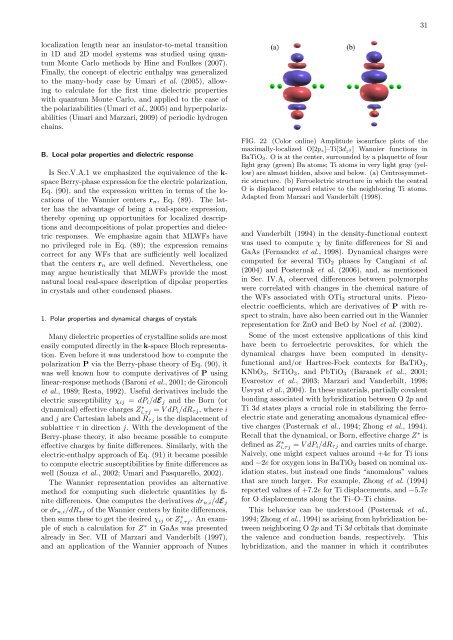Maximally localized Wannier functions: Theory and applications
Maximally localized Wannier functions: Theory and applications
Maximally localized Wannier functions: Theory and applications
Create successful ePaper yourself
Turn your PDF publications into a flip-book with our unique Google optimized e-Paper software.
31<br />
localization length near an insulator-to-metal transition<br />
in 1D <strong>and</strong> 2D model systems was studied using quantum<br />
Monte Carlo methods by Hine <strong>and</strong> Foulkes (2007).<br />
Finally, the concept of electric enthalpy was generalized<br />
to the many-body case by Umari et al. (2005), allowing<br />
to calculate for the first time dielectric properties<br />
with quantum Monte Carlo, <strong>and</strong> applied to the case of<br />
the polarizabilities (Umari et al., 2005) <strong>and</strong> hyperpolarizabilities<br />
(Umari <strong>and</strong> Marzari, 2009) of periodic hydrogen<br />
chains.<br />
B. Local polar properties <strong>and</strong> dielectric response<br />
Is Sec.V.A.1 we emphasized the equivalence of the k-<br />
space Berry-phase expression for the electric polarization,<br />
Eq. (90), <strong>and</strong> the expression written in terms of the locations<br />
of the <strong>Wannier</strong> centers r n , Eq. (89). The latter<br />
has the advantage of being a real-space expression,<br />
thereby opening up opportunities for <strong>localized</strong> descriptions<br />
<strong>and</strong> decompositions of polar properties <strong>and</strong> dielectric<br />
responses. We emphasize again that MLWFs have<br />
no privileged role in Eq. (89); the expression remains<br />
correct for any WFs that are sufficiently well <strong>localized</strong><br />
that the centers r n are well defined. Nevertheless, one<br />
may argue heuristically that MLWFs provide the most<br />
natural local real-space description of dipolar properties<br />
in crystals <strong>and</strong> other condensed phases.<br />
1. Polar properties <strong>and</strong> dynamical charges of crystals<br />
Many dielectric properties of crystalline solids are most<br />
easily computed directly in the k-space Bloch representation.<br />
Even before it was understood how to compute the<br />
polarization P via the Berry-phase theory of Eq. (90), it<br />
was well known how to compute derivatives of P using<br />
linear-response methods (Baroni et al., 2001; de Gironcoli<br />
et al., 1989; Resta, 1992). Useful derivatives include the<br />
electric susceptibility χ ij = dP i /dE j <strong>and</strong> the Born (or<br />
dynamical) effective charges Zi,τj ∗ = V dP i/dR τj , where i<br />
<strong>and</strong> j are Cartesian labels <strong>and</strong> R τj is the displacement of<br />
sublattice τ in direction j. With the development of the<br />
Berry-phase theory, it also became possible to compute<br />
effective charges by finite differences. Similarly, with the<br />
electric-enthalpy approach of Eq. (91) it became possible<br />
to compute electric susceptibilities by finite differences as<br />
well (Souza et al., 2002; Umari <strong>and</strong> Pasquarello, 2002).<br />
The <strong>Wannier</strong> representation provides an alternative<br />
method for computing such dielectric quantities by finite<br />
differences. One computes the derivatives dr n,i /dE j<br />
or dr n,i /dR τj of the <strong>Wannier</strong> centers by finite differences,<br />
then sums these to get the desired χ ij or Zi,τj ∗ . An example<br />
of such a calculation for Z ∗ in GaAs was presented<br />
already in Sec. VII of Marzari <strong>and</strong> V<strong>and</strong>erbilt (1997),<br />
<strong>and</strong> an application of the <strong>Wannier</strong> approach of Nunes<br />
FIG. 22 (Color online) Amplitude isosurface plots of the<br />
maximally-<strong>localized</strong> O[2p z ]–Ti[3d z 2] <strong>Wannier</strong> <strong>functions</strong> in<br />
BaTiO 3 . O is at the center, surrounded by a plaquette of four<br />
light gray (green) Ba atoms; Ti atoms in very light gray (yellow)<br />
are almost hidden, above <strong>and</strong> below. (a) Centrosymmetric<br />
structure. (b) Ferroelectric structure in which the central<br />
O is displaced upward relative to the neighboring Ti atoms.<br />
Adapted from Marzari <strong>and</strong> V<strong>and</strong>erbilt (1998).<br />
<strong>and</strong> V<strong>and</strong>erbilt (1994) in the density-functional context<br />
was used to compute χ by finite differences for Si <strong>and</strong><br />
GaAs (Fern<strong>and</strong>ez et al., 1998). Dynamical charges were<br />
computed for several TiO 2 phases by Cangiani et al.<br />
(2004) <strong>and</strong> Posternak et al. (2006), <strong>and</strong>, as mentioned<br />
in Sec. IV.A, observed differences between polymorphs<br />
were correlated with changes in the chemical nature of<br />
the WFs associated with OTi 3 structural units. Piezoelectric<br />
coefficients, which are derivatives of P with respect<br />
to strain, have also been carried out in the <strong>Wannier</strong><br />
representation for ZnO <strong>and</strong> BeO by Noel et al. (2002).<br />
Some of the most extensive <strong>applications</strong> of this kind<br />
have been to ferroelectric perovskites, for which the<br />
dynamical charges have been computed in densityfunctional<br />
<strong>and</strong>/or Hartree-Fock contexts for BaTiO 3 ,<br />
KNbO 3 , SrTiO 3 , <strong>and</strong> PbTiO 3 (Baranek et al., 2001;<br />
Evarestov et al., 2003; Marzari <strong>and</strong> V<strong>and</strong>erbilt, 1998;<br />
Usvyat et al., 2004). In these materials, partially covalent<br />
bonding associated with hybridization between O 2p <strong>and</strong><br />
Ti 3d states plays a crucial role in stabilizing the ferroelectric<br />
state <strong>and</strong> generating anomalous dynamical effective<br />
charges (Posternak et al., 1994; Zhong et al., 1994).<br />
Recall that the dynamical, or Born, effective charge Z ∗ is<br />
defined as Zi,τj ∗ = V dP i/dR τj <strong>and</strong> carries units of charge.<br />
Naively, one might expect values around +4e for Ti ions<br />
<strong>and</strong> −2e for oxygen ions in BaTiO 3 based on nominal oxidation<br />
states, but instead one finds “anomalous” values<br />
that are much larger. For example, Zhong et al. (1994)<br />
reported values of +7.2e for Ti displacements, <strong>and</strong> −5.7e<br />
for O displacements along the Ti–O–Ti chains.<br />
This behavior can be understood (Posternak et al.,<br />
1994; Zhong et al., 1994) as arising from hybridization between<br />
neighboring O 2p <strong>and</strong> Ti 3d orbitals that dominate<br />
the valence <strong>and</strong> conduction b<strong>and</strong>s, respectively. This<br />
hybridization, <strong>and</strong> the manner in which it contributes













